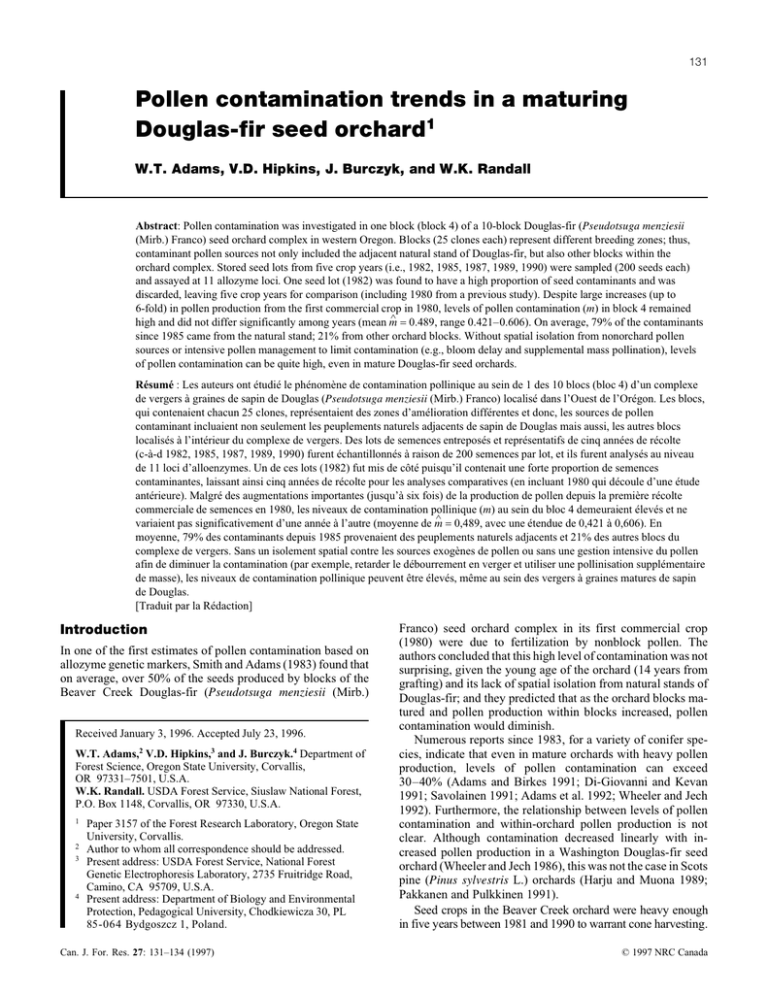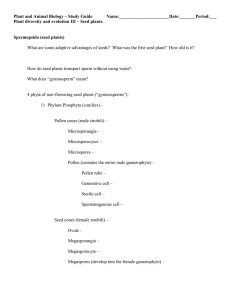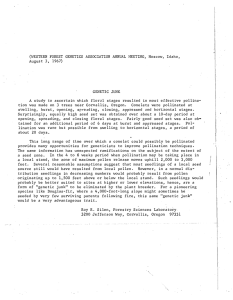Pollen contamination trends in a maturing Douglas-fir seed orchard 1
advertisement

131 Pollen contamination trends in a maturing Douglas-fir seed orchard1 W.T. Adams, V.D. Hipkins, J. Burczyk, and W.K. Randall Abstract: Pollen contamination was investigated in one block (block 4) of a 10-block Douglas-fir (Pseudotsuga menziesii (Mirb.) Franco) seed orchard complex in western Oregon. Blocks (25 clones each) represent different breeding zones; thus, contaminant pollen sources not only included the adjacent natural stand of Douglas-fir, but also other blocks within the orchard complex. Stored seed lots from five crop years (i.e., 1982, 1985, 1987, 1989, 1990) were sampled (200 seeds each) and assayed at 11 allozyme loci. One seed lot (1982) was found to have a high proportion of seed contaminants and was discarded, leaving five crop years for comparison (including 1980 from a previous study). Despite large increases (up to 6-fold) in pollen production from the first commercial crop in 1980, levels of pollen contamination (m) in block 4 remained ^ = 0.489, range 0.421–0.606). On average, 79% of the contaminants high and did not differ significantly among years (mean m since 1985 came from the natural stand; 21% from other orchard blocks. Without spatial isolation from nonorchard pollen sources or intensive pollen management to limit contamination (e.g., bloom delay and supplemental mass pollination), levels of pollen contamination can be quite high, even in mature Douglas-fir seed orchards. Résumé : Les auteurs ont étudié le phénomène de contamination pollinique au sein de 1 des 10 blocs (bloc 4) d’un complexe de vergers à graines de sapin de Douglas (Pseudotsuga menziesii (Mirb.) Franco) localisé dans l’Ouest de l’Orégon. Les blocs, qui contenaient chacun 25 clones, représentaient des zones d’amélioration différentes et donc, les sources de pollen contaminant incluaient non seulement les peuplements naturels adjacents de sapin de Douglas mais aussi, les autres blocs localisés à l’intérieur du complexe de vergers. Des lots de semences entreposés et représentatifs de cinq années de récolte (c-à-d 1982, 1985, 1987, 1989, 1990) furent échantillonnés à raison de 200 semences par lot, et ils furent analysés au niveau de 11 loci d’alloenzymes. Un de ces lots (1982) fut mis de côté puisqu’il contenait une forte proportion de semences contaminantes, laissant ainsi cinq années de récolte pour les analyses comparatives (en incluant 1980 qui découle d’une étude antérieure). Malgré des augmentations importantes (jusqu’à six fois) de la production de pollen depuis la première récolte commerciale de semences en 1980, les niveaux de contamination pollinique (m) au sein du bloc 4 demeuraient élevés et ne ^ = 0,489, avec une étendue de 0,421 à 0,606). En variaient pas significativement d’une année à l’autre (moyenne de m moyenne, 79% des contaminants depuis 1985 provenaient des peuplements naturels adjacents et 21% des autres blocs du complexe de vergers. Sans un isolement spatial contre les sources exogènes de pollen ou sans une gestion intensive du pollen afin de diminuer la contamination (par exemple, retarder le débourrement en verger et utiliser une pollinisation supplémentaire de masse), les niveaux de contamination pollinique peuvent être élevés, même au sein des vergers à graines matures de sapin de Douglas. [Traduit par la Rédaction] Introduction In one of the first estimates of pollen contamination based on allozyme genetic markers, Smith and Adams (1983) found that on average, over 50% of the seeds produced by blocks of the Beaver Creek Douglas-fir (Pseudotsuga menziesii (Mirb.) Received January 3, 1996. Accepted July 23, 1996. W.T. Adams,2 V.D. Hipkins,3 and J. Burczyk.4 Department of Forest Science, Oregon State University, Corvallis, OR 97331–7501, U.S.A. W.K. Randall. USDA Forest Service, Siuslaw National Forest, P.O. Box 1148, Corvallis, OR 97330, U.S.A. 1 2 3 4 Paper 3157 of the Forest Research Laboratory, Oregon State University, Corvallis. Author to whom all correspondence should be addressed. Present address: USDA Forest Service, National Forest Genetic Electrophoresis Laboratory, 2735 Fruitridge Road, Camino, CA 95709, U.S.A. Present address: Department of Biology and Environmental Protection, Pedagogical University, Chodkiewicza 30, PL 85-064 Bydgoszcz 1, Poland. Can. J. For. Res. 27: 131–134 (1997) Franco) seed orchard complex in its first commercial crop (1980) were due to fertilization by nonblock pollen. The authors concluded that this high level of contamination was not surprising, given the young age of the orchard (14 years from grafting) and its lack of spatial isolation from natural stands of Douglas-fir; and they predicted that as the orchard blocks matured and pollen production within blocks increased, pollen contamination would diminish. Numerous reports since 1983, for a variety of conifer species, indicate that even in mature orchards with heavy pollen production, levels of pollen contamination can exceed 30–40% (Adams and Birkes 1991; Di-Giovanni and Kevan 1991; Savolainen 1991; Adams et al. 1992; Wheeler and Jech 1992). Furthermore, the relationship between levels of pollen contamination and within-orchard pollen production is not clear. Although contamination decreased linearly with increased pollen production in a Washington Douglas-fir seed orchard (Wheeler and Jech 1986), this was not the case in Scots pine (Pinus sylvestris L.) orchards (Harju and Muona 1989; Pakkanen and Pulkkinen 1991). Seed crops in the Beaver Creek orchard were heavy enough in five years between 1981 and 1990 to warrant cone harvesting. © 1997 NRC Canada 132 Stored seed lots from these years made it possible to examine trends in pollen contamination as the orchard matured. Materials and methods During 1980–1990 the Beaver Creek seed orchard (20 ha) consisted of a complex of 10 blocks containing clones representing nine breeding zones (geographical areas) in the central Coast Range in Oregon (one breeding zone was represented by two blocks). Based on the availability of stored seed crops, one block, block 4 (440 × 370 m) was chosen for study. This block was bordered by other orchard blocks to the east, west and south, and by a large, mature natural stand of Douglas-fir to the north, which surrounds the entire orchard complex on three sides. Only narrow roads separated block 4 from other blocks and from the adjacent natural stand. In 1980, the 25 clones in this block were represented by a total of 417 ramets, but, through thinning and natural mortality, this number was reduced to 181 by 1990 (all clones were still represented; Table 1). With the exception of periodic fertilization and mowing of grass, the orchard received no special treatments to enhance flowering or seed production prior to 1989. In spring 1988, however, ramets in the southern half of each orchard block were subjected to fertilization and partial girdling to induce heavy flowering the following year. Similarly, ramets in the remaining (northern) half of each block were stimulated in 1989 to induce flowering in 1990. Pollen fecundity of individual ramets was scored visually in good crop years and rough estimates of relative pollen production in block 4 were calculated (Table 1). Note that the relative pollen production in the two crop years with flower stimulation (1989 and 1990) was similar to 1987, when there was no stimulation. This is not surprising since only onehalf of the ramets were treated at a time. All blocks are expected to have had similar levels of pollen production each year because they were of similar size and received the same treatments. Unfortunately, no records were kept on pollen production in the adjacent natural stand. It has been observed, however, that trees in the natural stand begin shedding pollen up to 7 days before ramets in the orchard. Seed crops from block 4 were available in cold storage for each of the good crop years between 1981 and 1990 (i.e., 1982, 1985, 1987, 1989, 1990). In 1989 and 1990, cones were collected from only those ramets that had received flower stimulation the prior spring; in previous years cones were collected from all ramets with adequate cone crops. Two-hundred viable seeds from each stored lot were randomly sampled and subjected to starch gel electrophoresis following the procedures in Adams et al. (1990). The embryo and megagametophyte of each seed (recent germinant) were assayed separately, so that the haploid genotype of pollen gametes could be determined (Adams 1983) at 11 allozyme loci: Pgm1, Pgi2, Got1, Got2, Got3, G6pd, Cat, Gdh, 6Pgd, Idh, and Dia. Genotypes of the 25 clones in block 4, as well as all 206 clones in the remaining orchard blocks and a sample of 178 trees up to 200 m away in the natural stand adjacent to the orchard, were determined previously for the same 11 loci (Adams 1983; Smith and Adams 1983). Genotypes of the clones and trees outside block 4 were used to estimate allele frequencies in background (contaminant) pollen sources. Allele frequencies were first calculated for each source (orchard and natural stand) separately, but because the estimated frequencies were nearly identical in the two sources (mean difference of 0.015, range 0–0.082), they were simply averaged to obtain background pollen-pool frequencies. Estimation of pollen contamination in each sampled crop year was facilitated by using GENFLOW, a computer program written in Turbo BASIC (Adams and Burczyk 1993). Details of the multilocus estimation procedure are found elsewhere (Smith and Adams 1983; Friedman and Adams 1985; Adams and Birkes 1991; and in the documentation of GENFLOW); only a brief description follows. The first step was to compare the 11-locus genotype of each pollen gamete in the seed crop sample with gamete genotypes that can be produced by clones in block 4. All pollen gametes that could not have been pro- Can. J. For. Res. Vol. 27, 1997 duced by block 4 clones were detected contaminants. The proportion of detected contaminants is a minimum estimate of pollen contamination because some contaminants are likely to have multilocus genotypes indistinguishable from those that can be produced by block 4 clones. To estimate the true proportion of contaminants (m), we note that the probability of observing a detected contaminant (b) is equal to md, where d is the probability that a contaminant pollen grain has ^ =b^ / d^. Using a detectable genotype (detection probability); so that, m estimated pollen pool allele frequencies, GENFLOW calculates d^ as 1 – h, where h is the frequency of multilocus pollen gametes in the background source that can be produced by clones in the block. GENFLOW also estimates a large sample approximation of the variance of ^ , which is a more exact formulation of var(m ^ ) than given in Smith m and Adams (1983), since it takes into account error variances in both b^ and d^ (see documentation in GENFLOW). Smith and Adams’ esti^ ) is simpler to calculate, but is downwardly biased mator for var(m because d^ is assumed to be known without error. The above estimate of m is for all sources of background pollen. Because the genotypes of all clones in all blocks of the Beaver Creek complex are known, it was also possible to enumerate pollen gametes with genotypes that could not have been produced by any clone within the complex (i.e., detected contaminants from the natural stand, b^ns) and to estimate pollen contamination due to the natural stand only ^ =b^ /d^ , where d is the probability of detecting contaminants (m ns ns ns ns from the natural stand). Finally, because the megagametophyte of each seed was assayed, we had information on the 11-locus genotypes of egg gametes, as well as pollen gametes. We compared the sample of egg gametes from each seed crop with the gamete genotypes that could be produced by block 4 clones to check for contamination in female parentage that might have occurred during seed collection and processing. The observed proportion of contaminants, b^f, is a minimum estimate of seed contamination. Results and discussion Seed contamination Seed contamination was detected in four of the five seed crops sampled (none detected in 1985), but b^f did not exceed 1% in three of these years (0.5%, 0.5%, and 1.0%, respectively, in 1987, 1989, and 1990). In 1982, however,b^f was 18%. If we assume the same detection probability estimated for pollen gametes, the proportion of seed contaminants would have to be nearly 100% for such a high value of b^f. This suggests that the 1982 seed lot is not from block 4, but was mislabeled somehow during the seed extraction or storage process. For this reason, the 1982 seed crop is not considered further in this study. The low level of detected contaminants in other years may be due to (1) gel reading errors, (2) seed contamination during processing, or (3) the presence of maternal genotypes in block 4 other than the 25 clones accounted for in the analysis (Paule 1991). No errors were detected in the labelling of 91 ramets (22% of total) sampled in block 4 in an earlier study (Adams 1983). Thus, if there are unaccounted maternal genotypes in block 4, they probably occur at very low frequency. Pollen contamination Because of the detected seed contaminants, pollen contamination from all background sources was estimated in two ways. First, the low-level of seed contamination was simply ignored ^ by first subtract(unadjusted estimate). We also calculated m ^ ^ ing bf from b and then dividing this adjusted value by d^ to obtain an estimate of pollen contamination adjusted for seed © 1997 NRC Canada 133 Notes Table 1. Pollen production in Beaver Creek block 4, 1980–1990. Year* 1980 1982 1985 1987 1989 1990 Total ramets 417 323 193 192 182 181 Ramets producing pollen† % of total 47 21 90 91 87 55 Light 197 51 56 101 89 25 Pollen production‡ 197 231 1226 841 789 775 Heavy 0 18 117 74 70 75 *Seed crops in 1989 and 1990 were collected from ramets in one-half of the orchard block subjected to flower stimulation treatments the prior spring. No flower stimulation was applied in the earlier crop years. † Ramets were scored visually into one of three classes: no pollen cones, light pollen crop, and heavy crop. ‡ A rough estimate of the relative pollen production each year was calculated as (number of ramets with light crop) + (number with heavy crop) × 10. ^ ) in block 4. Table 2. Estimates of pollen contamination (m Year 1980§ 1985 1987 1989 1990 Mean Pollen gametes sampled b^† 256 200 200 200 200 0.176 0.080 0.100 0.080 0.115 All Sources* ^ d^‡ m 0.376 0.190 0.190 0.190 0.190 0.468 0.421 0.527 0.421 0.606 0.489 ^) SE (m b^ns† 0.063 0.104 0.116 0.104 0.124 0.047 0.027 0.020 0.015 0.015 0.010 Natural stand only ^ ^ ) d^ns‡ m SE (m ns ns 0.106 0.039 0.039 0.039 0.039 0.255 0.519|| 0.389 0.389 0.259 0.362 0.096 0.276 0.237 0.237 0.193 0.097 *Includes pollen from other blocks in the orchard complex as well as from the surrounding natural stands. † Frequency of detected contaminants. ‡ Detection probability. § Estimates in 1980 are based on 14 allozyme loci (unpublished; Smith and Adams 1983) and on 11 loci in the remaining years. || ^ is large. The true value of mns cannot be greater than m, but the standard error of m ns contamination. Adjusted and unadjusted estimates of m were quite similar, differing on average by only 5% (range 0–8.7%); thus, we present only the unadjusted values (Table 2). There is no evidence that pollen contamination decreased in block 4 as clones matured. In fact, a heterogeneity test indicates that the five estimates of m between 1980 and 1990 are not significantly different (χ2 = 1.87, 0.50 < P < 0.75); this despite the fact that the relative pollen production within this block ranged 6-fold over this period (Table 1). Thus, although pollen production in block 4 increased substantially after 1980, background pollen concentrations remained sufficiently strong to maintain high contamination levels. One possible explanation for the sustained high level of pollen contamination in block 4 is that increased pollen production in other blocks within the complex nullified elevated pollen production in block 4. One might suppose, therefore, that while total pollen contamination has remained relatively constant, the proportion of contamination due to other orchard blocks has increased, while that due to the surrounding natural stand has decreased. This hypothesis is not supported by the ^ are characterized by data (Table 2). Yearly estimates of m ns ^ ^ high standard errors because dns is very low, and although m ns ranged 2-fold over years, the differences were not significant (χ2 = 1.187, 0.75 < P < 0.90). Pooling data over the four crop years between 1985 and 1990, the proportion of pollen contamination due to the surrounding natural stand averaged 79%, which is nearly identical with the orchard-wide value of 77% calculated for the 1980 seed crop (Smith and Adams 1983). Thus, pollen contamination in this orchard has continued to be primarily the consequence of pollen competition from the adjacent natural stand. One strategy for lowering pollen contamination at Beaver Creek is to treat all ramets with flower stimulation in a portion (e.g., one-third) of the blocks each year, rather than just half the ramets in all blocks. In this way, relative pollen production within blocks can be increased and some spatial isolation between blocks can be achieved by keeping the blocks stimulated in any one year as far from each other as possible. It is doubtful, however, that this strategy will reduce pollen contamination to completely acceptable levels. Without extensive spatial isolation from large natural stands (1 or more miles (1 mi = 1.6 km); Schmidt and Hamblett 1962; Silen 1962), high levels of pollen competition from background sources can be expected in wind-pollinated seed orchards. In lieu of controlled pollination, only intensive management regimes involving supplemental mass pollination and (or) bloom delay appear to be © 1997 NRC Canada 134 successful in substantially reducing pollen contamination in nonisolated Douglas-fir blocks (El-Kassaby and Ritland 1986a, 1986b; Wheeler and Jech 1986). Acknowledgements We thank the USDA Forest Service Region 6 for financial support and for providing seed for this study, and Dr. David Birkes for help in formulating the estimator of the ^. variance of m References Adams, W.T. 1983. Application of isozymes in tree breeding. In Isozymes in plant genetics and breeding, part A. Edited by S.D. Tanksley and T.J. Orton. Elsevier Science Publishers B.V., Amsterdam. pp. 381–400. Adams, W.T., and Birkes, D.S. 1991. Estimating mating patterns in forest tree populations. In Biochemical markers in the population genetics of forest trees. Edited by S. Fineschi, M.E. Malvolti, F. Cannata, and H.H. Hattemer. S.P.B. Academic Publishing bv, The Hague, Netherlands. pp. 157–172. Adams, W.T., and Burczyk, J. 1993.GENFLOW: a computer program for estimating levels of pollen contamination in clonal seed orchards. Release 1. Department of Forest Science, Oregon State University, Corvallis. [A copy of this program can be obtained by sending a previously unused 3.5-in. diskette to either W.T. Adams, or J. Burczyk.] Adams, W.T., Neale, D.B., Doerksen, A.H., and Smith, D.B. 1990. Inheritance and linkage of isozyme variants from seed and vegetative bud tissues in coastal Douglas-fir [Pseudotsuga menziesii var. menziesii (Mirb.) Franco]. Silvae Genet. 39: 153–167. Adams, W.T., Birkes, D.S., and Erickson, V.J. 1992. Using genetic markers to measure gene flow and pollen dispersal in forest tree seed orchards. In Ecology and evolution of plant reproduction. Edited by R. Wyatt. Chapman and Hall, New York. pp. 37–61. Di-Giovanni, P., and Kevan, P.G. 1991. Factors affecting pollen dynamics and its importance to pollen competition: a review. Can. J. For. Res. 21: 1155–1170. El-Kassaby, Y.A., and Ritland, K. 1986a. Low levels of pollen con- Can. J. For. Res. Vol. 27, 1997 tamination in a Douglas- fir seed orchard as detected by allozyme markers. Silvae Genet. 35: 224–229. El-Kassaby, Y.A., and Ritland, K. 1986b. The relation of outcrossing and contamination to reproductive phenology and supplemental mass pollination in a Douglas-fir seed orchard. Silvae Genet. 35: 240–244. Friedman, S.T., and Adams, W.T. 1985. Estimation of gene flow into two seed orchards of loblolly pine (Pinus taeda L.). Theor. Appl. Genet. 69: 609–615. Harju, A., and Muona, O. 1989. Background pollination in Pinus sylvestris seed orchards. Scand. J. For. Res. 4: 513–520. Pakkanen, A., and Pulkkinen, P. 1991. Pollen production and background pollination levels in Scots pine seed orchards of northern Finnish origin. In Proceedings of the Meeting of the Nordic Group for Tree Breeding 1991. Edited by D. Lindgren. Swedish University of Agricultural Sciences, Department of Forest Genetics and Plant Physiology, Umeå. Rep. 10. pp. 14– 21. Paule, L. 1991. Clone identity and contamination in a Scots pine seed orchard. In Proceedings of the Meeting of the Nordic Group for Tree Breeding 1991. Edited by D. Lindgren. Swedish University of Agricultural Sciences, Department of Forest Genetics and Plant Physiology, Umeå. Rep. 10. pp. 22–32. Savolainen, O. 1991. Pollen contamination in seed orchards. In Proceedings of the Meeting of the Nordic Group for Tree Breeding 1991. Edited by D. Lindgren. Swedish University of Agricultural Sciences, Department of Forest Genetics and Plant Physiology, Umeå. Rep. 10. pp. 6–13. Schmidt, R.L. and Hamblett, K.C. 1962. Directional source of extraneous pollen at three seed orchard sites on Vancouver Island. For. Chron. 38: 203–207. Silen, R.R. 1962. Pollen dispersal considerations for Douglas-fir. J. For. 60: 790–795. Smith, D.B., and Adams, W.T. 1983. Measuring pollen contamination in clonal seed orchards with the aid of genetic markers. Proc. 17th South. For. Tree Improve. Conf. (Athens, Ga.), 17: 69–77. Wheeler, N., and Jech, K. 1986. Pollen contamination in a mature Douglas-fir seed orchard. In Proceedings IUFRO Conference on Breeding Theory, Progeny Testing and Seed Orchards, 12–17 Oct. 1986, Williamsburg, Va. Edited by R.J. Weir. North Carolina State University, Raleigh. pp. 160–171. Wheeler, N., and Jech, K. 1992. The use of electrophoretic markers in seed orchard research. New For. 6: 311–328. © 1997 NRC Canada





